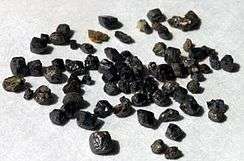Tausonite
| Tausonite | |
|---|---|
 | |
| General | |
| Category | Oxide mineral |
| Formula (repeating unit) | SrTiO3 |
| Strunz classification | 4.CC.35 |
| Crystal symmetry |
Isometric hexoctahedral H-M symbol: (4/m32/m) Space group: P m3m |
| Unit cell | a = 3.9 Å; Z=1 |
| Identification | |
| Color | Red, red-brown, orange, dark gray |
| Crystal habit | Cubic and octahedral crystals, granular, massive |
| Crystal system | Cubic |
| Cleavage | None |
| Fracture | Conchoidal |
| Tenacity | Brittle |
| Mohs scale hardness | 6-6.5 |
| Luster | Adamantine |
| Diaphaneity | Translucent to opaque |
| Specific gravity | 4.88 |
| Optical properties | Isotropic |
| Refractive index | n = 2.40 |
| References | [1][2][3] |
Tausonite is the rare naturally occurring mineral form of strontium titanate: chemical formula: SrTiO3. It occurs as red to orange brown cubic crystals and crystal masses.
It is a member of the perovskite group.
It was first described in 1982 for an occurrence in a syenite intrusive in Tausonite Hill, Murunskii Massif, Aldan Shield, Sakha Republic, Yakutia, Eastern-Siberian Region, Russia.[1] It was named for Russian geochemist Lev Vladimirovich Tauson (1917–1989).[3] It has also been reported from a fenite dike associated with a carbonatite complex in Sarambi, Concepción Department, Paraguay.[2] and in high pressure metamorphic rocks along the Kotaki River area of Honshu Island, Japan.[1]
References
This article is issued from Wikipedia - version of the Tuesday, November 10, 2015. The text is available under the Creative Commons Attribution/Share Alike but additional terms may apply for the media files.